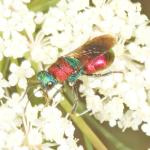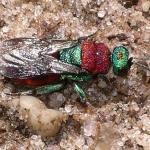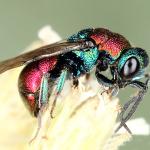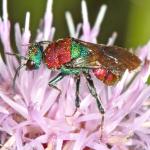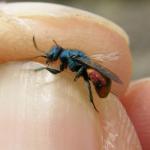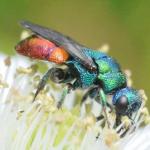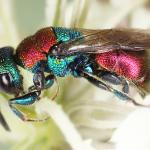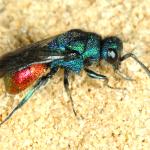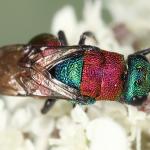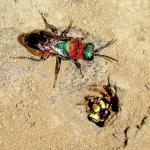Hedychrum aureicolle ssp. niemelai LINSENMAIER 1959
Previously known as Hedychrum nobile, a misidentification, and H. aureicolle Mocsary. Identification keys and general biology are given in Morgan (1984), Falk (1991) and Kunz (1994).
A very similar species - Hedychrum nobile - was recently discovered in Britain. The separation of H. niemelai and H. nobile is described in this paper
Recorded from Cornwall to Kent and north to Oxfordshire, Norfolk and Lincolnshire. Also found in Jersey.
The first map shows records for Hedychrum niemelai agg. The name Hedychrum niemelai has been applied to both H. neimelai and H. nobile in the
past. Older records (pre 2015) based on non-rexamined vouchers are mapped here. The second map shows only records for Hedychrum niemelai iso. Paukkunen et al: 2017
Overseas found in Europe (including Norway, Sweden, Finland, The Netherlands, France including Corsica, Spain, Portugal, Germany, Switzerland, Italy including Sicily, Poland, Austria, Hungary,and the former Yugoslavia), Asia (Turkey across to Siberia and Manchuria) and north Africa (Morocco).
Not listed in Shirt (1987). Falk (1991) lists it as Rare (pRDB3). Work for this atlas suggests that its status requires review.
Care with records pre 2015. The name Hedychrum niemelai has been applied to both H. neimelai and H. nobile in the past. Separation of specimens is difficult, but possible. However this should be done with reference to Paukkunen at al 2015, or later key.
Open sandy localities: lowland heaths, coastal dunes, cliffs with sandy deposits, and other disturbed locations, for example sandpits, footpaths and railway cuttings. Adults fly in bright sunshine around nesting sites of the hosts and feed at the nectaries and extra-floral nectaries of flowering plants.
Probably univoltine; mainly during July and August, but also during June and September and rarely during May.
Clary (Salvia spp.) goldenrod (Solidago virgaurea), woundwort (Stachys spp.), and yarrow (Achillea millefolium).
No information available.


